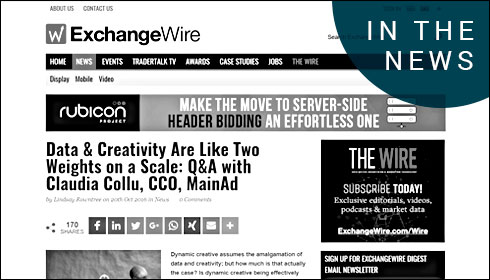
Data & Creativity are like two weights on a scale: Claudia Collu Q&A
Dynamic creative assumes the amalgamation of data and creativity; but how much is that actually the case? Is dynamic creative being effectively implemented by advertisers and how can it be best put to use? Claudia Collu (pictured below), chief commercial officer, MainAd, explains to ExchangeWire how well dynamic creative is being used across the industry.
ExchangeWire: Is dynamic creative currently being used to its full potential?
Claudia Collu: Dynamic creative has been around for a while – the format has hit a point of maturity and is now a commodity. Experienced marketers approach dynamic creative with a fair amount of confidence, although there’s always a risk of being tedious for customers. It’s a well-known fact that people are able to block out advertising. Unless brands can prove they are worth the attention, the awareness can be harmful. After all, there is such a thing as bad publicity!
What is the one element overlooked by advertisers when adopting dynamic creative into their campaigns?
At MainAd, we’ve actually identified three: design, format, and relevance.
The first one has to do with creativity. The standard dynamic creative design is a sterile cookie-cutter format where logo and product picture are placed against a white background. Since the early days, we decided this wasn’t the direction we wanted to take. The whole point of dynamic creative is to engage prospects into a meaningful conversation. Given it’s personalised, the message is only as good as the sender, hence the need for the brand to be recognisable.
Secondly, it is crucial for the ad media setup to be appropriate in regards of device and context. A desktop ad, for example, will have more cues in the creative than the mobile version, where space is much smaller and easily cluttered. Similarly, Facebook ads should be heavier on visuals over text because it creates greater engagement in this medium.
The last element relates to frequency caps. Bombarding the user with the same repetitive banner creates a terrible user experience, which in turn causes detachment towards the brand. Buyers, those precious few in the bunch, are savvy and, hence, must be treated accordingly. Once they delete cookies, the one chance is lost, but also possible future engagement opportunities, and this is the greatest danger of all. In the rush of closing a deal, advertisers are sometimes short-sighted in firing all bullets at once. Instead, the focus should be placed on creating a relationship organically over time, nurtured bit by bit to flourish.
What type of campaign best lends itself to dynamic creative? Is it more powerful for retargeting over prospecting, for example?

Claudia Collu, Chief Commercial Officer, MainAd
Dynamic creative campaigns work best in the lower part of the funnel, the reason being that the prospect has by then expressed preferences within the specific brand.
That said, any campaign based on data will benefit from dynamic creative. The logic relies on tailoring the messaging on individual preferences. The more that is learned about the user – by harnessing evidence – the more brands can expose them to different triggers. In prospecting, the algorithm relies on sociodemographic or interest-based inputs, where the match is between the brand and its prospect. Retargeting has more to do with intent than anything else, so the prospect is matched with the brand along with its specific products.
How can advertisers maximise the relationship between creative and data in dynamic creative?
Data and creativity are like two weights on a scale. Achieving balance requires both sides to weigh the same.
Creativity has to do with design as much as it relates to strategy. As with every successful solution, it’s all about testing. This format presents fundamental components, such as content, visuals, and action triggers, all relying on adequate application of the creative and data combo. Historic evidence will teach us which product combinations are most successful in cross-selling. Or that the button’s colour might work better on the background. Whether the highest click-through rate is achieved by a message on delivery options or return policy, is again an answer to be gained by testing.
Even more significant in providing direction for the strategy, are the correlations between cues. Data storage, management, and analysis must be carried throughout the process. However, this operation can become overwhelming, or even impossible, to execute when the appropriate expertise and technology are missing. Support from skilled marketers can be crucial in implementing a meticulous approach.
A concern of dynamic creative is that the use of data and automation impacts creativity – do you believe this to be the case?
We always say at MainAd that it is called dynamic ‘creative’ for a reason. It might be tempting to just do the due diligence at the beginning of the process, relying on automation for the steps to come, but the best results are only achieved by continuous tweaks.
First published on exchangewire.com by Lindsay Rowntree. Read the full article here.